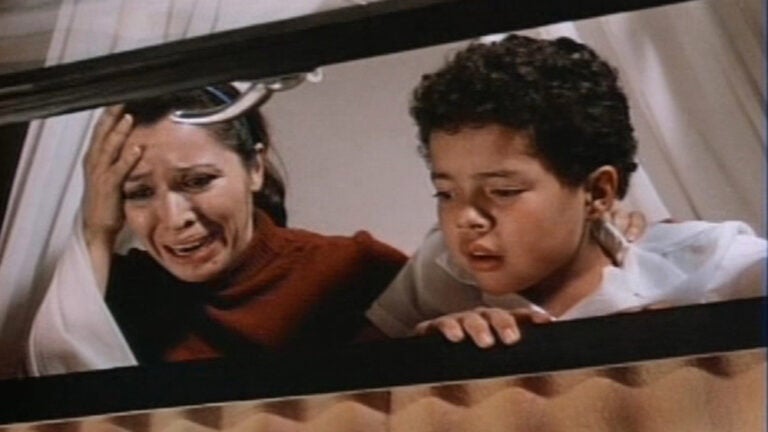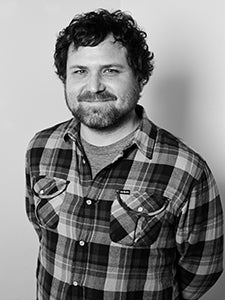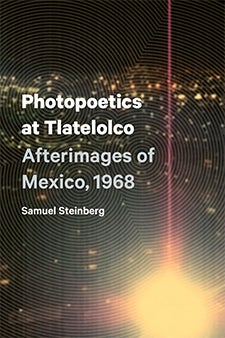
Book sheds new light on Mexico’s Tlatelolco student massacre of 1968
In a still from Mexican director Jorge Fons’ 1989 film Red Dawn, a young boy and his mother gaze down from an apartment window onto students protesting in the Plaza de la Tres Culturas in Tlatelolco, Mexico City, where a tragedy is about to unfold.
It is Oct. 2, 1968, and like many countries around the world, Mexico is experiencing student-led revolt. However, unlike Paris, which romanticized its 1968 cultural and sexual revolution as a celebration of youth, and London, where youthful rebellion was expressed principally through music and fashion, Mexico’s student movement ended in bloodshed when up to 300 young protesters (the exact number is still unknown) were murdered by paramilitaries in a state-sponsored massacre.
Examining artifacts ranging from documentary photography and testimony to poetry, essays, cinema, literary texts, and performance, a new book by USC Dornsife’s Samuel Steinberg, Photopoetics at Tlatelolco: Afterimages of Mexico, 1968 (University of Texas Press, 2016), explores the state’s dual repression in terms of both the massacre’s crushing effects on the movement and the manipulation of cultural discourse and political thought in the aftermath. Through this lens, Steinberg considers the broad photographic and photopoetic nature of modern witnessing as well as the specific elements of light (gunfire, flares, camera flashes) that he argues ultimately defined the massacre.
“In Red Dawn — one of the artifacts I explore in my book — it is highly significant that the only movie made about Mexico 1968 doesn’t show us the students once,” said Steinberg, assistant professor of Spanish and Portuguese. “Instead, we in the audience take the place of those about to be massacred because we are placed in the position of looking up at the window from the square where the students are about to be killed.”
In a medieval theatre technique often seen in Shakespeare, the mother and son then witness and describe the massacre to the audience.

Samuel Steinberg, assistant professor of Spanish and Portuguese. Photo by Meiko Arquillos.
“We’re never shown the massacre itself,” Steinberg notes. “Instead, it’s seen through the eyes of the family — symbolically representing the nation.”
This approach, he argues, summarizes the problem of how the Mexican student movement of 1968 has been considered and portrayed — by the authorities as well as by historians and artists.
“The way that we think about Mexico 1968 approaches the way the Mexican state reimagined the story of 1968 for us,” he said. “So in a perverse way, the history of Mexico 1968 became about the massacre, which brought the student movement to an end, rather than the movement itself. In Mexico, the only remnant of 1968 is this image of a mass grave — an image that completely overshadows the student movement. To me, that assumes the form of a double defeat.”
Red Dawn, which was clandestinely filmed and initially censored, represents yet another effort to turn the massacre into a national tragedy, Steinberg said. This is problematic, he argues, because it attempts to transform an oppositional political event into a shared experience rather than an act of violence against a particular group. “It’s a way of reigning in the conflict around the event,” he said.
The massacre occurred 10 days before the opening of the 1968 Olympics, hailed as the first time that a so-called developing country had been allowed to host the Games.
“Keen to avoid any press, the Mexican state overplayed its hand in crushing the student movement rather than opting for the less obvious mechanisms it customarily used to contain dissidents,” Steinberg said. “The spectacular massacre it engineered backfired, principally because it was too evidently a result of state repression.”

Samuel Steinberg’s book Photopoetics at Tlatelolco (University of Texas Press, 2016) offers readers a more theoretical approach to the history of Mexico’s student movement and the massacre that ended it.
During the student protests at Tlatelolco, the army moved in to surround the square. When unknown snipers started firing down on the military, the army began firing back — at the students. The gunmen were later identified as members of the Olympia Battalion, a state paramilitary organization.
“All the provocateurs were wearing white gloves so they could identify each other,” Steinberg said. “Photos and testimonies of people who were there bear witness to the collaboration between the paramilitary brigade and the military.”
Steinberg had initially thought of writing a global study of 1968, but decided instead to focus on Mexico.
“It wasn’t the massacre itself that interested me, but the student movement,” he said. “I was drawn to Mexico ‘68 because very little critical work had been done about this topic. Most of it was fairly historiographic or sociological and consisted of reconstruction. I was more interested in thinking critically about how that reconstruction actually occurred.”
By exploring the period through the perspective of visual studies, Steinberg offers readers an alternative, more theoretical approach.
“The idea behind the book was to think about the way 1968 is forged using light as a memory that we can reflect upon and the way this memory is framed and structured around this light,” he said. “For instance, the signal to start the massacre was given by flares dropped from a helicopter — that’s how the gunmen knew to shoot. The book also thinks about weapons as a kind of light and cameras in terms of light making.
“In Mexico, people don’t even want to think about 1968 in many ways because the memory industry around it is already so oppressive. By looking at the student movement in a broader sense, my hope is that this book — the first nonhistoriographic exploration of Mexico 1968 in English — can free Mexico 1968 from the way dominant historical narrative has presented it up until now and recover its lost legacy.”